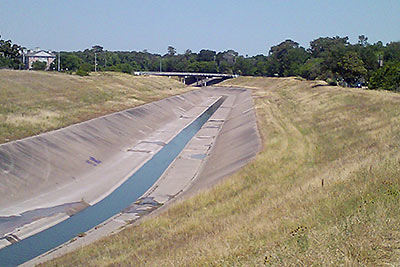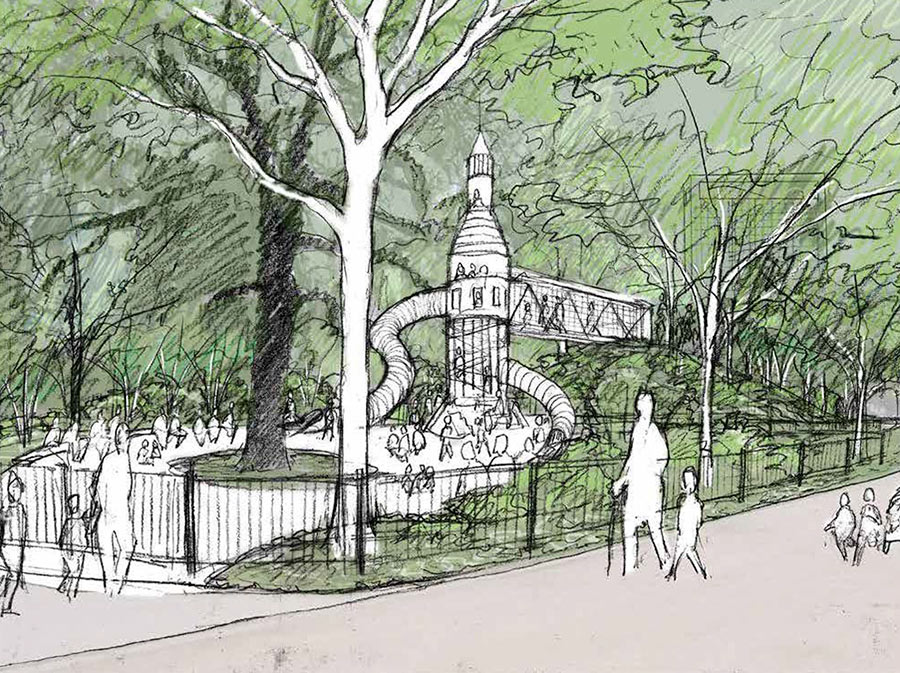MIGHT WHITE OAK BAYOU DITCH ITS CONCRETE?  The Harris County Flood Control District is looking at removing the concrete lining from sections of the White Oak Bayou channel, writes Mihir Zaveri. The agency is conducting a study on redeveloping parts of the waterway along with the Memorial-Heights Redevelopment Authority (a.k.a. TIRZ 5); any future projects to come from the study would be within the TIRZ 5 boundaries, along sections of White Oak between roughly N. 610 and Houston St. Zaveri writes that the push “in part reflects the idea that waterways where flooding must be controlled don’t have to be eyesores, and in fact can become more natural settings for residents to bike, walk and gather. It follows decades-old conversations about how to shape waterways in a flood-prone region like Houston, where the rapidly growing population has increasingly come to demand improvements in quality of life.” With respect to balancing aesthetics against effective flood control practices, TIRZ 5 chairwoman Ann Lents tells Zaveri that “pretty is never going to trump functional . . . But because of new techniques, if we can find a way to do both better, I think that will be a great thing.” [Houston Chronicle] Photo of White Oak Bayou: Swamplot inbox
The Harris County Flood Control District is looking at removing the concrete lining from sections of the White Oak Bayou channel, writes Mihir Zaveri. The agency is conducting a study on redeveloping parts of the waterway along with the Memorial-Heights Redevelopment Authority (a.k.a. TIRZ 5); any future projects to come from the study would be within the TIRZ 5 boundaries, along sections of White Oak between roughly N. 610 and Houston St. Zaveri writes that the push “in part reflects the idea that waterways where flooding must be controlled don’t have to be eyesores, and in fact can become more natural settings for residents to bike, walk and gather. It follows decades-old conversations about how to shape waterways in a flood-prone region like Houston, where the rapidly growing population has increasingly come to demand improvements in quality of life.” With respect to balancing aesthetics against effective flood control practices, TIRZ 5 chairwoman Ann Lents tells Zaveri that “pretty is never going to trump functional . . . But because of new techniques, if we can find a way to do both better, I think that will be a great thing.” [Houston Chronicle] Photo of White Oak Bayou: Swamplot inbox





Do it
Concreting drainage areas as practice has been thoroughly discredited for at least 20 years.
If they can do it for White Oak, why not Brays through the med center?
This would be awesome! All that concrete looks so desolate and lifeless.
I don’t want them spending money on aesthetics until they’ve solved flooding.
Do it!
@Memebag
Flooding will never be completely solved in a city like Houston, but this would be part of flood control efforts. Concrete linings aren’t as effective as they were thought to be when the Bayous were first lined.
Please, God…yes!
@Heightsresident: That’s my point. Any money spent breaking concrete and making the bayou pretty could be spent actually improving flood control. Concrete channels may not help control flooding as much as once thought, but getting rid of them won’t help at all. Flood control money should be spent controlling floods. No one’s house should be flooded because the Harris County Flood Control District decided to make a bayou prettier.
.
And ugly is in the eye of the beholder. Concrete ditches look like my Houston and all of y’all who want to replace them with riparian forest are a bunch of Houston haters. Embrace the brutality of your built environment.
While this would be a welcome change for all, still screams misappropriated TIRZ money that could be more efficiently spent elsewhere for the time being. But if they’ve already started throwing down money on studies I guess it’s too late.
I’m in slight agreement with Memebag’s comment – the concrete lining is a “sunk cost” to use an economic term. It is already done so just leave it alone and spend the beautification money on other (effective) flood control projects.
.
The benefit of this is that you’ll have a control group (White Oak, Brays Bayou, et cetera) to compare effectiveness with whatever future bayou is left in a more riparian state.
People are literally dying because of flood problems. Government should focus on mitigating those issues in an effective manner before worrying about how pretty things are.
It has been shown in studies that channeling and concrete lining of bayous in some ways causes more flooding than natural drainage systems. I wouldn’t want a lot of money spent on this solely for esthetic reasons, since the main issue is flooding, however until the powers that be understand that no matter what we do to the bayous will have little effect on flooding until we recognize the serious problems created by hundreds of large scale developments built and under construction. These developments out on the coastal prairies and wetlands that were our first line of defense against flooding in the western edges of our metropolis and their watersheds
have been decimated and the value of water being able to soak back into the soil slowly and eventually into the aquifers is not there anymore. The runoff from these new developments and all of the concrete infrastructure is allowing the water to move across large areas much faster. .The more of this development will exacerbate the problem and no amount of work in the city can solve this issue. The alternatives are to add detention ponds which helps some, widen the bayous to handle more water, but the suggestion of dredging the bayous to new depths won’t work since we are practically on flat ground and it has no more slope to move water downstream.
Suburban sprawl is the enemy. And when the defenders of these huge land grabbing developments suggest that they are trapping this water in their detention ponds don’t believe it. Because they don’t catch nearly as much as gets by.
@memebag,
.
I don’t think you understand. the concrete linings actually are part of the problem. The purpose of the concrete linings was to keep the water flowing in the direction they wanted, IE no erosion, and straightening the channel. It was thought that straightening and lining with concrete so that development of subdivisions right up to the edge of the water to maximize land usage wouldn’t hurt drainage.
.
However, now it is understood that a more natural system is actually better for the whole process. While yes, concrete lining is great to direct the water wherever you want, and it stops erosion. It is in fact, exacerbating the floods.
.
The problem doesn’t however lie solely with the new developments. It lies with all developments that are within a certain distance of the bayous. Even downtown Houston. The mistakes previous developers made are being multiplied by new developments out in the suburbs.
While I am no run-off water channeling expert, I am under the impression that tossing out the concrete is not just for appearances. The concrete ditch moves the water faster than the natural channel, and can actually aggravate flooding rather than cure it. Returning to the natural channel structure may mitigate flooding.
Toasty I agree with what you said. but my point is that these well marketed master planned communities continue to eat away at what little is left of a natural process that allows the water to sit in these few wetlands and slowly run off or evaporate and be absorbed in the ground. Also the scale of these new rural suburban villages is overwhelming. They take up so much of the available recharge areas.
Add to the problem most of these outlying communities are built with MUDS, which usually get their water from underground and this eventually causes major subsidence issues which come back and haunt those areas.
The only thing that is actually good about these rural suburban communities is price and schools, and thats what makes them successful in attracting more and more people into them, unfortunately.
Houstonians not wanting tax monies spent on anything “aesthetic”? Don’t worry, the total lack of concern for “aesthetics” shows big time in this city when compared to others and I doubt that pisspoor mentality will be going away anytime soon.
We have to move the water out faster, and we aren’t going to buy up the developed land near White Oak Bayou to allow more erosion and retention. This is all about making diverting money from flood control to quality of life. Until we evolve gills flood control has to come first.
Looks like it’s working pretty good to me.
Since when does TIRZ 5 have ‘rights’ to spend money all the way to the Loop? I must have missed that Council action.
@BobR
” but the suggestion of dredging the bayous to new depths won’t work since we are practically on flat ground and it has no more slope to move water downstream.”
As was demonstrated in the Heights during last years’ Memorial Day floods. When White Oak hit capacity, street drainage stopped abruptly. It was insane. I thought my block’s drains must have gotten blocked with leaves and waded through knee deep water (on the sidewalk!) to try and clear them. They were fine. There was simply no gradient, so the water just kept accumulating.
I don’t know how the heck you mitigate that. White Oak already has an overflow valve in the form of the parkland (and the Elan apartments parking garage, and Lucky’s Heights 1st floor) – how much more can be done?
Civil engineer here – drainage expert – and I just want to set the record straight because some people here are posting comments that are not factual or based on real life physics.
Concrete lined channels increase the velocity of the water flow due to the smooth surface and decreased friction along its surface compared to a natural/grass-lined channel. This has the effect of increasing the total flow volume the bayou is capable of conveying.
If we went back to natural channel linings, there would be some increased infiltration, but only to a point that the ground is saturated. Then, the remaining flow would still be contained within the channel and we would be relying on that channel’s ability to CONVEY the water as quickly as possible to avoid it stacking up in front of our home(s).
I live near Brays Bayou and based on my experience I am happy that the US Army Corps chose to line our bayous when they did. Do I love the look? No, I am outdoorsman and prefer a natural look. Do I want my house to flood? Absolutely not, and the concrete lined bayou is one part of the flood defense system we have in place. Infiltration rates would not offset the increased conveyance capacity of the smooth bottomed ditch. I believe our flooding issues could be mitigated with increased drainage design standards, greater detention maintenance and oversight, and better policies regarding floodplain development mitigation. Ripping up concrete ditches would in no way improve the drainage system. It would certainly look nicer, but I believe it would be a step in the wrong direction and a poor use of taxpayer money.
Good points Guillo. Another thing to consider is groundwater preservation. Those concrete linings protect the more permeable sand and silt layers that outcrop to the north of the city and underlie to areas to the south. These are the water-bearing strata used by some with water wells. Removing concrete would certainly increase contamination of the groundwater in the immediate areas but would also increase flows that would force contaminants further afield. This would not only be true for surface runoff local to the bayous, but likely for (almost) forgotten superfund issues such as the Sol-Lynn transformer dumpsite. It’s all connected down there. Sorry to all the aspiring aesthetes out there… you picked the wrong city. If this concrete is removed and not replaced, it will be because local concrete contractors haven’t paid their dues (which simply won’t happen!)
it would only make sense if they were also widening the cross-sectional area of the bayous as well. does anybody have any study PROVING that the concrete linings make the system work less effectively? i’m with Guillo on this one. you want the water to move out of the bayou system faster. if you slow it down, once it fills up, then it will be longer before the system can drain and thus allow flooded streets to resume draining into the bayous. is the hypothesis that the water moves through the system too fast, and upstream drainage rushes into the system and fills it before downstream storm sewer can drain into it? if that was the case, it seems like metering valves on storm sewer pipes would do more than trying to slow down the main drainage arteries.